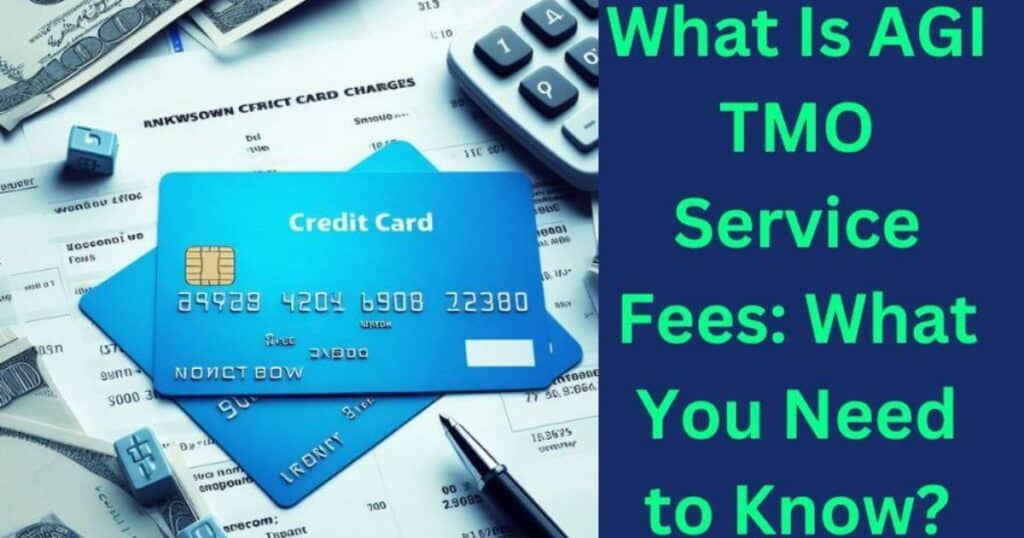Have you ever scrutinized your bank statement or credit card bill and noticed an unfamiliar charge labeled “AGI TMO Service Fee”? If so, you’re not alone. Many consumers find themselves puzzled by this mysterious fee, unsure of what it represents or why it’s being deducted from their accounts. In this comprehensive guide, we’ll demystify the AGI TMO Service Fee, exploring its purpose, calculation methods, and how to manage it effectively.
What is the AGI TMO Service Fee?
The AGI TMO Service Fee, also known as the “Account Gain/Interest Transaction Management Overhead” fee, is a charge that financial institutions and service providers often impose on various transactions. It’s not a singular, uniform fee but rather an umbrella term encompassing different types of charges related to the costs associated with providing specific services or facilitating transactions.
This fee is typically not tax-deductible, making it crucial for consumers to understand its purpose and how to manage it effectively. By doing so, you can make informed decisions about your financial transactions and avoid unexpected expenses.
Why did The Charge Come Up On the Statement?
At its core, the AGI TMO Service Fee serves as a mechanism for businesses and service providers to recover certain operational and administrative costs associated with offering their services. These fees can help offset expenses related to processing transactions, maintaining infrastructure, providing customer support, or handling other aspects of service delivery.
For businesses, implementing AGI TMO Service Fees can contribute to their overall profitability and sustainability, ensuring that they can continue providing valuable services to their customers. While these fees may seem like an additional burden, they often play a vital role in enabling the services you rely on daily.
Types of AGI TMO Service Fees
AGI TMO Service Fees can take various forms, depending on the industry, service provider, and the specific transaction or service being offered. Here are some common types of AGI TMO Service Fees you might encounter:
- Processing Fees: These fees cover the costs associated with handling and processing transactions, such as credit card payments, online purchases, or wire transfers. They are commonly found in the e-commerce, retail, and financial sectors.
- Maintenance Fees: In industries like banking, telecommunications, or subscription-based services, maintenance fees help cover the ongoing costs of maintaining and updating the necessary infrastructure, systems, and customer support services.
- Subscription Fees: Some businesses charge recurring fees, often monthly or annually, for access to their services or products. These fees are common among streaming platforms, software-as-a-service (SaaS) providers, and other subscription-based models.
- Service Charges: In the hospitality and food service industries, service charges are often added to bills to compensate staff or cover additional expenses related to the service provided.
- Convenience Fees: These fees are typically charged when you choose a payment or service option that is more convenient for you but incurs additional costs for the business. Examples include expedited shipping fees or fees for using a specific payment method.
How AGI TMO Service Fees Are Calculated
The calculation of AGI TMO Service Fees can vary significantly depending on the type of fee, the industry, and the specific service or transaction involved. However, there are some common factors that influence the fee amount:
- Percentage of Transaction: For processing fees, the fee amount is often calculated as a percentage of the total transaction value. This means that the higher the transaction amount, the higher the fee will be.
- Flat Rate: Some fees, such as maintenance fees or monthly subscription fees, are charged as a fixed amount, regardless of the transaction size or usage level.
- Tiered Pricing: In certain cases, fees may be structured using a tiered pricing model, where different rates apply based on different levels of usage or service. This approach is common in services that offer various packages or tiers of access.
- Fixed Fees plus Percentages: Some AGI TMO Service Fees may combine a fixed fee component with a percentage-based component, allowing businesses to cover both fixed costs and transaction-based costs.
It’s important to note that the calculation methods can vary widely among service providers, even within the same industry. As a consumer, it’s essential to review the terms and conditions carefully to understand how the fees are calculated for the specific services you’re using.
Transparency and Disclosure
Transparency and clear disclosure are crucial when it comes to AGI TMO Service Fees. Businesses and service providers are typically required to disclose these fees clearly to their customers, ensuring that consumers are fully informed about the charges they may incur.
This disclosure can take various forms, such as:
- Line Items on Bills or Statements: AGI TMO Service Fees should be clearly itemized on bills, statements, or invoices, with a clear description of the fee and its purpose.
- Terms and Conditions: Service providers often outline their fee structures, including AGI TMO Service Fees, in the terms and conditions or user agreements that customers must agree to when signing up for a service.
- Pricing Disclosures: In some cases, businesses may provide separate pricing disclosures or fee schedules that outline the various fees associated with their services, including AGI TMO Service Fees.
Regulations and requirements regarding fee disclosure can vary by jurisdiction and industry, but the overarching goal is to ensure that consumers are fully informed about the fees they are being charged. Transparency empowers consumers to make informed decisions and hold service providers accountable.
AGI TMO Service Fees in Different Sectors
AGI TMO Service Fees are not limited to a single industry or sector. They can be found across various fields, each with its own unique fee structures and practices. Let’s explore how AGI TMO Service Fees are applied in different sectors:
1. Finance and Banking
In the financial sector, AGI TMO Service Fees can take the form of maintenance fees for bank accounts, ATM withdrawal fees, foreign transaction fees on credit cards, or fees for wire transfers or other specialized banking services. These fees help banks and financial institutions cover the operational costs of maintaining customer accounts, processing transactions, and providing secure financial services.
2. Telecommunications
Telecom companies often charge AGI TMO Service Fees such as line access fees, activation fees, early termination fees, or fees for specialized services like international calling or data roaming. These fees contribute to the ongoing maintenance and upgrades of the telecommunications infrastructure, as well as customer support and service delivery.
3. E-Commerce and Retail
Online retailers and e-commerce platforms commonly apply AGI TMO Service Fees as processing fees for credit card transactions, PayPal fees, or fees for handling returns or exchanges. These fees help cover the costs associated with securely processing online payments, managing inventory, and providing customer service.
4. Subscription Services
Many subscription-based businesses, such as streaming platforms, magazines, software providers, or membership clubs, charge recurring AGI TMO Service Fees to maintain continuous access to their services or content. These fees can take the form of monthly or annual subscription fees, helping to cover the costs of content licensing, server maintenance, and customer support.
5. Hospitality and Food Service
In the hospitality and food service industries, AGI TMO Service Fees can include service charges, resort fees, delivery fees, or other charges related to the provision of services or amenities. These fees help cover the costs of maintaining facilities, compensating staff, and ensuring a high level of service for guests or customers.
Managing AGI TMO Service Fees
While AGI TMO Service Fees are a common aspect of many transactions and services, it’s important to manage them effectively to avoid unexpected expenses and maintain control over your finances. Here are some strategies to help you manage AGI TMO Service Fees:
- Review Statements Regularly: Make it a habit to carefully review your bank statements, credit card statements, and bills to identify any AGI TMO Service Fees or other charges. This will help you stay informed about what you’re being charged and catch any unauthorized or unexpected fees.
- Understand Terms and Agreements: When signing up for new services or making purchases, take the time to read the terms and conditions thoroughly. Look for information on any potential AGI TMO Service Fees or other charges that may apply.
- Budget for Fees: If you know that certain services or transactions will incur AGI TMO Service Fees, factor these fees into your budget to avoid financial surprises or strains.
- Negotiate or Explore Alternatives: If you believe a fee is unfair or excessive, don’t hesitate to contact the service provider and negotiate for a lower fee or explore alternative options that may have more favorable fee structures.
- Dispute Unauthorized Charges: If you come across AGI TMO Service Fees that you believe are unauthorized or incorrect, don’t hesitate to contact the service provider or your financial institution to dispute the charges. Be prepared to provide evidence and documentation to support your case.
- Consolidate Services: Consider consolidating multiple services or accounts with a single provider to potentially negotiate lower fees or benefit from bundled pricing options that may reduce overall AGI TMO Service Fees.
- Leverage Technology: Explore digital tools, mobile apps, or online platforms that can help you track and manage your expenses, including AGI TMO Service Fees. Many personal finance apps offer fee analysis and categorization features to help you stay on top of these charges.
- Seek Professional Advice: If you’re struggling to manage AGI TMO Service Fees or have complex financial situations, consider seeking guidance from a financial advisor or a consumer protection agency. They can provide valuable insights and strategies tailored to your specific circumstances.
Legal and Regulatory Considerations
It’s important to note that AGI TMO Service Fees are subject to various regulations and legal requirements, which can vary depending on the jurisdiction and industry. Governments and consumer protection agencies often have rules in place to ensure fair and transparent fee practices, aiming to protect consumer rights and prevent deceptive or misleading charges.
Some key legal and regulatory considerations regarding AGI TMO Service Fees include:
- Disclosure Requirements: As mentioned earlier, businesses and service providers are typically required to clearly disclose AGI TMO Service Fees and other charges to their customers. Failure to do so could potentially violate consumer protection laws or regulations.
- Fee Limits and Restrictions: In some cases, there may be limits or restrictions on the types or amounts of AGI TMO Service Fees that can be charged, particularly in industries with high regulatory oversight, such as banking or telecommunications.
- Consumer Protection Laws: Various consumer protection laws and regulations exist to prevent unfair or deceptive practices related to fees and charges. These laws aim to ensure transparency, fairness, and accountability from businesses and service providers.
- Industry-Specific Regulations: Certain industries may have specific regulations or guidelines regarding AGI TMO Service Fees or similar charges. For example, the financial services industry may have regulations related to banking fees, while the telecommunications industry may have rules governing activation or termination fees.
It’s essential to be aware of the legal and regulatory landscape surrounding AGI TMO Service Fees in your region or industry. Staying informed and understanding your rights as a consumer can help you navigate these fees more effectively and hold service providers accountable when necessary.
AGI TMO Service Fees vs. Other Fees
While AGI TMO Service Fees are a common type of charge, it’s important to distinguish them from other fees that you may encounter in financial transactions or service agreements. Here’s a brief comparison of AGI TMO Service Fees with some other common fees:
- Transaction Fees: Transaction fees are charges associated with individual transactions, such as ATM withdrawal fees, wire transfer fees, or foreign transaction fees on credit cards. These fees are typically applied on a per-transaction basis, whereas AGI TMO Service Fees may cover broader operational or service-related costs.
- Interest Charges: Interest charges are applied when you carry a balance on a loan, credit card, or other forms of credit. These charges are separate from AGI TMO Service Fees, which are typically related to the provision of services or transaction processing.
- Late Payment Fees: Many service providers and lenders charge late payment fees if you fail to make a payment by the due date. These fees are distinct from AGI TMO Service Fees and are intended to encourage timely payments.
- Subscription Fees: While some subscription fees may fall under the umbrella of AGI TMO Service Fees, not all subscription fees are classified as such. Subscription fees are typically recurring charges for ongoing access to a service or product, whereas AGI TMO Service Fees may cover additional costs beyond the basic subscription.
- Overdraft Fees: Overdraft fees are charged by banks when you attempt to withdraw or spend more money than is available in your account. These fees are separate from AGI TMO Service Fees, which are typically related to account maintenance or transaction processing.
Understanding the distinctions between AGI TMO Service Fees and other types of fees can help you better navigate and manage your financial transactions and service agreements. By being an informed consumer, you can make more informed decisions and ensure that the fees you’re paying are justified and transparent.
Final Thoughts
AGI TMO Service Fees are a common but often misunderstood aspect of various financial transactions and services. While they may seem confusing or frustrating at first glance, understanding their purpose, calculation methods, and the different types of fees can empower you to manage them effectively.
By staying vigilant, reading the fine print, and being an informed consumer, you can navigate the world of AGI TMO Service Fees with confidence. Remember to review your statements regularly, understand the terms and conditions of your agreements, and don’t hesitate to negotiate or seek alternatives if you believe a fee is unfair or excessive.
Transparency and clear disclosure from service providers are crucial in ensuring that consumers are fully informed about the fees they are being charged. By staying up-to-date with legal and regulatory developments, you can also protect your rights as a consumer and hold businesses accountable for any deceptive or unfair practices.
Ultimately, managing AGI TMO Service Fees is about taking control of your finances and making informed decisions that align with your financial goals and priorities. With the right knowledge and strategies, you can navigate these fees effectively and ensure that your hard-earned money is being used wisely.







